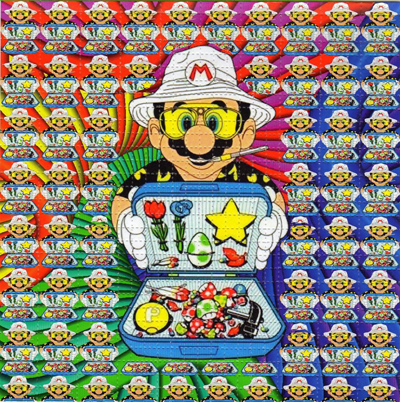
LSD, like most psychedelics in the tryptamine or phenethylamine classes, is a serotonin receptor agonist. An agonist is a substance that binds to a cell (in this case a neuron) and triggers a response (in this case the release of neurotransmitters).
Serotonin (chemical name 5-Hydroxytryptamine, or just 5-HT) is one of the human brain’s primary neurotransmitters. There are a variety of serotonin receptor systems in the brain. LSD acts primarily upon the 5-HT2A receptor system . Part of this system is located in the frontal lobe, which is one of the key parts of the brain involved in high-level cognitive function, including the incorporation of sensory input and mediation of the delineations between self and external.
So, essentially, what happens when you take LSD is the following:
- LSD enters the bloodstream
- LSD passes through the blood-brain-barrier (BBB)
- LSD starts binding to serotonin receptors (instead of just the serotonin that would normally be binding to them)
- This triggers new patterns of neurotransmission
The two primary effects(visual hallucinations, sense of connection to the universe) are generally believed to be consequences of the modified patterns of serotonin release. Outside visual stimulus doesn’t get processed in the same way, allowing other systems in the brain to influence your experience of visual perception. At the same time, because you’re not processing external input in the same way, your brain stops doing such a good job of effectively differentiating between your self and the surrounding world. As far as I’m aware, the exact mechanics of these processes are not all that well-understood beyond identification of the 5-HT2A system as the primary point of influence.
LSD is an ergoline derivative. It is commonly synthesized by reacting diethylamine with an activated form of lysergic acid. Activating reagents include phosphoryl chloride and peptide coupling reagents. Lysergic acid is made by alkaline hydrolysis of lysergamides like ergotamine, a substance usually derived from the ergot fungus on agar plate; or, theoretically possible, but impractical and uncommon, from ergine (lysergic acid amide, LSA) extracted from morning glory seeds. Lysergic acid can also be produced synthetically, eliminating the need for ergotamines.
The ingredients involved in making lsd after lysergic acid has been produced are: lysergic acid, thionyl chloride, diethylamine, ethanol, methanol, sodium hydroxide, Sodium sulfate, ether, and tartaric acid.

jjjjjj
Ergot is a fungus that infects rye seed and some other grains. It starts its infection by turning a rye seed black. The infected rye seed eventually sprouts small mushrooms, The fungus is then cultured and must be moved through a production that involves the chemicals anhydrous hydrazine or chloroform.
Ergot and its mushrooms contain powerful psychoactive alkaloids that are chemically similar to the psychoactive chemicals found in other commonly known hallucinogenic mushrooms like psilocybin. Scientists believe the chemical Ergine is responsible for the hallucinatory effects of ergot and some other hallucinogenic funguses and plants.
Ergot and its mushrooms are sometimes cultivated and grown on actual rye grains, on soil, or on other grains, but the ergot used for lsd production is most often grown on agar plate (large petri dishes) from ergot spores. The ‘sprouted’ baby ergot mushrooms are collected and processed into lysergic acid with the use of tartaric acid and/or Alkaline hydrolysis.

Next the lysergic acid is reacted with thionyl chloride, Diethylamine, ethanol, methanol, sodium hydroxide, Sodium sulfate, tartaric acid and ether, in a complex process to make lsd.
The pure lsd is extracted as a highly concentrated, mostly clear, odorless liquid, or (most often) crystalline powder. The powder is rehydrated and the liquid is bottled. A dropper is used to drip the rehydrated lsd onto “blotter paper” (a thick soft pulpy white cloth-like paper). Blotter paper sheets which are initially produced with no lsd, often come perforated and decorated with (food-grade) dyes.






